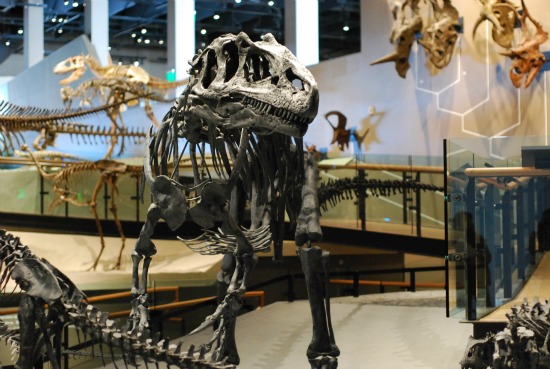Will We Ever Find All the Dinosaurs?
There are probably hundreds of dinosaurs that paleontologists have yet to discover, but will we ever find all the dinosaurs?
Allosaurus is one of the best-known dinosaurs, but it’s rare to find an extensive record of any single dinosaur genus. And there are some dinosaurs that we may never meet at all. (Photo taken at the Natural History Museum of Utah by the author)
During the past two centuries, paleontologists have discovered and named over 600 different non-avian dinosaur genera. At first glance, that might seem like a lot of dinosaur diversity (especially since only a handful of dinosaurs are well-known to the public). But it’s really just the tip of the Mesozoic iceberg. New dinosaurs are being described on a near-weekly basis, and, as estimated by paleontologists Steve Wang and Peter Dodson in 2006, there may have been over 1,800 different genera of dinosaur present on earth during their 160 million year reign between the Triassic and the end of the Cretaceous. Most dinosaurs remain undiscovered.
But will we ever find all the dinosaurs? I don’t think so.
The fossil record is a history biased by the circumstances required for preservation and discovery. Paleontologists and geologists have recognized this for over a century and a half. As Charles Darwin, following the argument of his geologist friend and colleague Charles Lyell, pointed out in On the Origin of Species, the geological record is “a history of the world imperfectly kept and written in a changing dialect.” Consider the world’s strata to be like pages of a book that record the comings and goings of species over time, Darwin wrote. “Of this history we possess the last volume alone, relating only to two or three countries,” Darwin lamented, and “Of this volume, only here and there a short chapter has been preserved, and of each page, only here and there a few lines.”
Let’s apply this to dinosaurs. Of all the non-avian dinosaurs that ever existed, only a few died in circumstances amenable to fossil preservation. Dinosaurs bodies had to settle in a place where sediment was being laid down – a river, lake, dune-covered desert, floodplain, lagoon, or similar environment – to be preserved for the rock record. This means that we know a lot about lowland dinosaurs who lived near bodies of water, but dinosaurs that lived in upland habitats are not so well represented. These dinosaurs, who inhabited ancient mountains and similar habitats, were living in places where rock was being stripped away rather than new sediment laid down. In other words, upland dinosaurs didn’t live in the kind of habitats where they were likely to become preserved. There were undoubtedly entire populations, species, and even genera of dinosaurs that may have never entered the fossil record.
And preservation in the fossil record alone isn’t a guarantee that a particular dinosaur genus will be discovered. Of all the dinosaurs preserved in the rock, only a few are accessible in exposed portions of rock around the world. Fewer still are intact enough to identify and collect. The contingencies of fossilization, history, and our ability to search for fossils conspire to blur our picture of dinosaur diversity.
The picture isn’t entirely negative, though. There are swaths of dinosaur-bearing rock that are, as yet, little explored, and even extensively-searched areas can still yield surprises. I have no doubt whatsoever that paleontologists will continue to discover and describe previously-unknown dinosaurs for many decades to come. And, more than that, each new dinosaur tweaks our picture of dinosaur relationships and the details of when and where particular groups evolved. Using this knowledge, paleontologists can go back to the rock and target specific areas where new dinosaurs might be found. We probably won’t find every single dinosaur genus that ever existed, and we may not have an intricately-detailed record of every genus that we’re lucky enough to discover, but there is still an overwhelming array of dinosaurs out there waiting to be found.
/https://tf-cmsv2-smithsonianmag-media.s3.amazonaws.com/accounts/headshot/RileyBlack.png)

/https://tf-cmsv2-smithsonianmag-media.s3.amazonaws.com/accounts/headshot/RileyBlack.png)